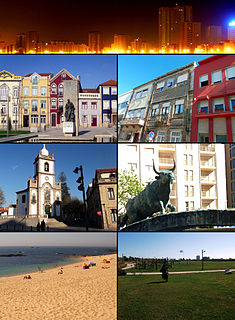
There are several religious or popular celebrations, pilgrimages (romarias) and processions (procissão) in Póvoa de Varzim, Portugal. Most of these festivals occur around the Holy week or during the summer.

Póvoa de Varzim, in Portugal is an ethno-cultural entity stemming from its working classes and with influences arriving from the maritime route from the Baltic Sea to the Mediterranean. The most charismatic of its communities, formerly overwhelmingly dominant, is the fisher community. It has significant similarities with those of the Danish fjords and it is one of Portugal's oldest ports. Póvoa de Varzim has distinct cultural traits and a strong local identity.

Póvoa de Varzim, with an area of 82.06 square kilometres, lies between the Cávado and Ave Rivers, or, from a wider perspective, halfway between the Minho and Douro Rivers on the northern coast of Portugal. Although in administrative reforms of 1936, the city was integrated in Douro Litoral, the case for such an administrative integration is arguable, because Póvoa de Varzim is found in a transition region. It has characteristic Minho traditions, historical and demographic bounds with several towns and villages in the region, religiously it is part of Braga archdiocese, and due to that it is perhaps preferable to recognize Póvoa as part of the old region, favouring more Entre-Douro-e-Minho, given its central geographic position in this region.
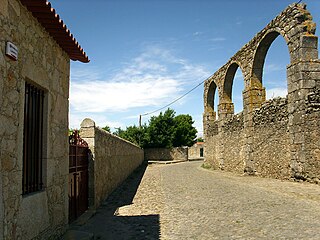
Argivai is an urban area in Póvoa de Varzim, Portugal. It is an ancient ecclesiastical parish and former civil parish located in the city of Póvoa de Varzim. In the census of 2001, it had a population of 2,187 inhabitants and a total area of 2.32 km². A 2012 law merged the parish with neighbouring Póvoa de Varzim (parish) and Beiriz, becoming the southern parish of the city of Póvoa de Varzim, with a population of 34,266 inhabitants and a total area of 11.88 km².
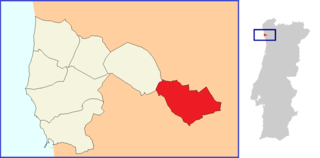
Balazar is one of the seven parishes of the municipality of Póvoa de Varzim. The population in 2011 was 2,543, in an area of 11.61 km².

Bairro Sul, literally the South Neighborhood, also known as Lapa, is the fishery district of the city of Póvoa de Varzim in Portugal. It is one of the six traditional neighborhoods of Póvoa de Varzim and one of the eleven parts in which the city is subdivided. The quarter is situated south of Póvoa de Varzim City Center. It has green and white as neighborhood colors and Lancha Poveira as symbol, also the icon of the city.

São Félix Hill or Mount São Félix, Monte de São Félix in Portuguese, is the highest hill in Póvoa de Varzim, Portugal, as measured by the height above sea level of its summit, 202 metres (663 ft).

Diana Bar is a beach library and gallery in Póvoa de Varzim, Portugal. Before being a public library it was a historic café with the same name. It is located in the south end of the city's main waterfront avenue, the Banhos Avenue.
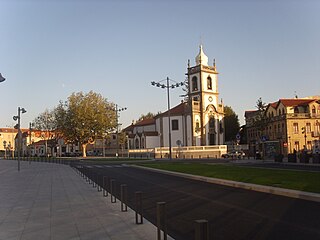
Largo das Dores or Dores Square is a square in Póvoa de Varzim city center in Portugal. Part of the earliest old town of Póvoa de Varzim, this area is listed by City Hall as heritage site. With about 11.000 square meters, its most noticeable features are its two churches, located in the sites of ancient chapels, one of which was the main church of the city.
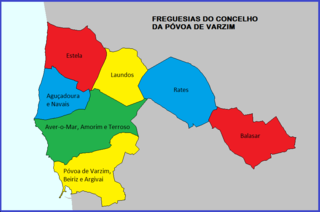
Póvoa de Varzim is divided into seven civil parishes, most of which were created as civil entities in the 19th century and some were merged in the 21st century, but are directly derived from ecclesiastical parishes existing since the Early Middle Ages. These parishes are grouped into three areas recognized by the Municipal masterplan: urban (city), suburban and rural.
Casa dos Poveiros is the name given to regionalist voluntary associations of Portuguese settlers or immigrants from Póvoa de Varzim, for community meeting and the promotion of the culture of Póvoa de Varzim.

Espaço Agros is an Agros organization business park and headquarters located in a 22 hectares park, located in the Portuguese city of Póvoa de Varzim, with woods and ancient farming fields.

Póvoa de Varzim Holiday, Saint Peter Festivals or Saint Peter Night is celebrated annually on June 29, Saint Peter's Day in Póvoa de Varzim, Portugal. It is a late midsummer festival and the last of the three Portuguese popular saints — Santos Populares. It is celebrated with the lighting of bonfires, dances, competitions between quarters and diverse parties. Saint Peter festival includes the "rusgas", in which inhabitants of one quarter (bairro) visit in a parade other quarters in the evening of June 28. Women are dressed as tricana poveira. Each neighborhood has its own festival, neighborhood colors and altar to Saint Peter.
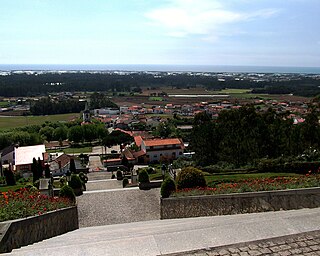
Around the city of Póvoa de Varzim in Portugal there is a large number of dependent settlements or hamlets dispersed in the civil parishes. These parishes have dispersed settlement, with small clusters that are called Lugares or Localidades (localities) in Portugal, these hamlets are also known as villages (aldeias) and most of the municipal territory and beyond is actually continuous, in urban terms, with the city in the highways that link it to neighbouring cities such as Barcelos, Famalicão or Esposende, the same occurs to the South, and several of these hamlets are suburbs with a number of separate farmsteads scattered throughout the area.
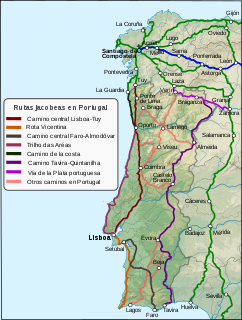
The Portuguese Way is the name of the Camino de Santiago pilgrimage routes starting in Portugal. It begins at Porto or Lisbon. From Porto, along the Douro River, pilgrims travel north crossing the five main rivers—the Ave, Cávado, Neiva, Lima and Minho—before entering Spain and passing through Padron on the way to Santiago de Compostela.

